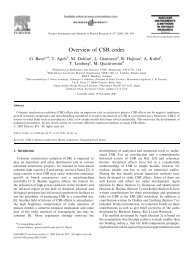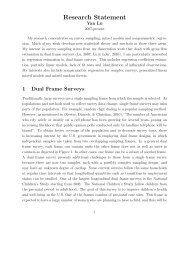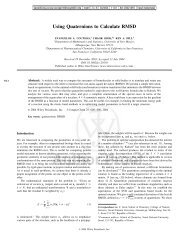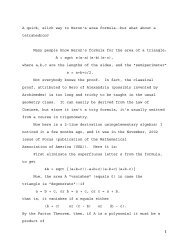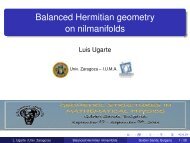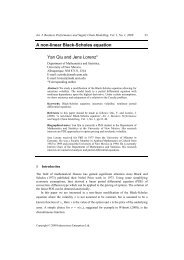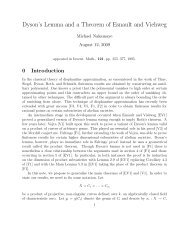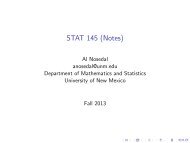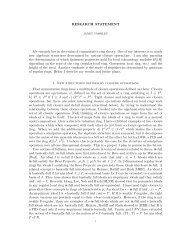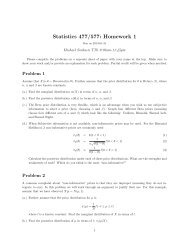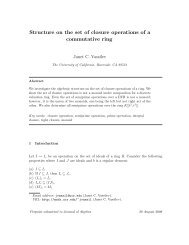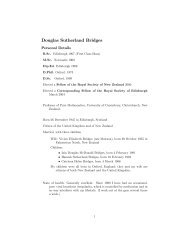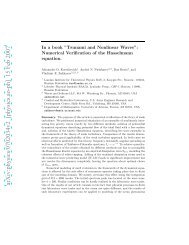OEO Office of Equal Opportunity - Department of Mathematics and ...
OEO Office of Equal Opportunity - Department of Mathematics and ...
OEO Office of Equal Opportunity - Department of Mathematics and ...
Create successful ePaper yourself
Turn your PDF publications into a flip-book with our unique Google optimized e-Paper software.
264 ARTS AND SCIENCES<br />
General Interest Courses in<br />
Physics <strong>and</strong> Astronomy<br />
ASTR 101. Introduction to Astronomy. (3)<br />
Conceptual description <strong>of</strong> our fascinating universe: early<br />
astronomy, Newtonian synthesis, Earth, Moon, planets, asteroids,<br />
comets, the Sun, our solar system, stars, black holes,<br />
galaxies, dark matter, dark energy <strong>and</strong> cosmological mysteries.<br />
Meets New Mexico Lower Division General Education<br />
Common Core Curriculum Area III: Science (NMCCN 1114).<br />
ASTR 101L. Astronomy Laboratory. (1)<br />
Intended as an adjunct to ASTR 101, this course deals with<br />
elementary techniques in astronomical observations. Two<br />
hrs. Meets New Mexico Lower Division General Education<br />
Common Core Curriculum Area III: Science (NMCCN 1114).<br />
Pre- or corequisite: ASTR 101.<br />
ASTR 109. Selected Topics in Astronomy. (1-3 to a<br />
maximum <strong>of</strong> 12) ∆<br />
Designed as a follow-up course to 101. This course will focus<br />
on one topic in astronomy for an in-depth investigation <strong>of</strong> its<br />
core concepts <strong>and</strong> implications. May be repeated but topics<br />
must be substantially different from semester to semester.<br />
Prerequisites: 101. {Offered upon dem<strong>and</strong>.}<br />
PHYC 102. Introduction to Physics. (3)<br />
Designed to introduce non-science majors to basic concepts,<br />
laws <strong>and</strong> skills in physics, in various applications to ordinary<br />
life. Energy, momentum, force, wave phenomena, electric<br />
charge <strong>and</strong> light are discussed, also basic properties <strong>of</strong><br />
gravitational, electromagnetic <strong>and</strong> nuclear forces. Selections<br />
from relativity, quantum theory, atoms <strong>and</strong> molecules will be<br />
included. See PHYC 102L for an optional laboratory. Meets<br />
New Mexico Lower Division General Education Common<br />
Core Curriculum Area III: Science.<br />
PHYC 102L. Physics Laboratory. (1)<br />
Students involve themselves in experiments <strong>and</strong> projects<br />
showing basic concepts related to the atom, the environment<br />
<strong>and</strong> the universe. Meets New Mexico Lower Division General<br />
Education Common Core Curriculum Area III: Science.<br />
Pre- or corequisite: 102. Two hrs. lab.<br />
PHYC 105. Physics <strong>and</strong> Society. (3)<br />
Designed to introduce non-science majors to basic concepts,<br />
laws <strong>and</strong> skills in classical <strong>and</strong> quantum physics as a basis<br />
to discuss the interrelationships <strong>of</strong> society <strong>and</strong> physics.<br />
Examples where energy, momentum, special relativity, thermal<br />
physics, quantum <strong>and</strong> nuclear physics have important<br />
roles are discussed; these could include meteorology, aviation<br />
weather, fission <strong>and</strong> fusion reactors, science policy <strong>and</strong><br />
ethics, alternative energy sources. {Spring}<br />
PHYC 106. Light <strong>and</strong> Color. (3)<br />
Designed to introduce non-science majors to basic concepts,<br />
laws <strong>and</strong> skills in classical <strong>and</strong> quantum physics,<br />
in the context <strong>of</strong> a study <strong>of</strong> light <strong>and</strong> color. Light as flow <strong>of</strong><br />
energy, propagating rays, vibrating waves <strong>and</strong> as photons;<br />
interactions with matter; in rainbows, sunsets, iridescence;<br />
in technology <strong>and</strong> art: cameras, telescopes, the human eye,<br />
color <strong>and</strong> color perception; lasers <strong>and</strong> holography. See PHYC<br />
106L for an optional laboratory. {Fall}<br />
PHYC 106L. Light <strong>and</strong> Color Laboratory. (1)<br />
Students involve themselves in experiments <strong>and</strong> demonstrations<br />
with optical phenomena: lenses, mirrors, the eye,<br />
interference, polarization, lasers, holography.<br />
Pre- or corequisite: 106. Two hrs. lab. {Fall}<br />
PHYC 107. Problems for Introduction to Physics. (1)<br />
Instructor-led study session for PHYC 102, including problem<br />
solving <strong>and</strong> demonstrations.<br />
Corequisite: 102. Offered on a CR/NC basis only.<br />
PHYC 108. Introduction to Musical Acoustics. (3)<br />
Designed to introduce non-science majors to basic concepts,<br />
laws <strong>and</strong> skills in physics, in the context <strong>of</strong> a study <strong>of</strong> sound,<br />
acoustics <strong>and</strong> music. Energy <strong>and</strong> force involved with the<br />
physical nature <strong>of</strong> sound waves; application to harmonics,<br />
tone quality, pitch. Sound production, propagation, detection<br />
<strong>and</strong> perception are demonstrated <strong>and</strong> illustrated by many<br />
different musical instruments, building acoustics <strong>and</strong> the<br />
behavior <strong>of</strong> the voice <strong>and</strong> the ear. See PHYC 108L for an<br />
optional laboratory. {Spring}<br />
PHYC 108L. Musical Acoustics Laboratory. (1)<br />
Student involvement in experiments <strong>and</strong> demonstrations<br />
with sound waves, measurements <strong>of</strong> properties <strong>of</strong> musical<br />
instruments <strong>and</strong> electronic equipment measuring musical <strong>and</strong><br />
acoustic properties.<br />
Pre- or corequisite: 108. Two hrs. lab. {Spring}<br />
Physics (PHYC)<br />
For PHYC 102 through 108L, see the general interest<br />
courses described above.<br />
151. General Physics. (3)<br />
Mechanics, sound, heat, fluid, waves. The sequence (151,<br />
151L, 152, 152L) is required <strong>of</strong> pre-medical, pre-dental,<br />
<strong>and</strong> pre-optometry students. Only 151 <strong>and</strong> 152 are required<br />
<strong>of</strong> pharmacy students. Meets New Mexico Lower Division<br />
General Education Common Core Curriculum Area III:<br />
Science (NMCCN 1114).<br />
Prerequisite: MATH 150 or MATH 180 or ACT >27 SAT >630.<br />
{Summer, Fall, Spring}.<br />
151L. General Physics Laboratory. (1)<br />
Mechanics, sound, heat. Meets New Mexico Lower Division<br />
General Education Common Core Curriculum Area III:<br />
Science (NMCCN 1114).<br />
Pre- or corequisite: 151. Three hrs. lab.<br />
152. General Physics. (3)<br />
Electricity, magnetism, optics. Meets New Mexico Lower<br />
Division General Education Common Core Curriculum Area<br />
III: Science (NMCCN 1124).<br />
Prerequisite: 151.<br />
152L. General Physics Laboratory. (1)<br />
Electricity, magnetism, optics. Meets New Mexico Lower<br />
Division General Education Common Core Curriculum Area<br />
III: Science (NMCCN 1124).<br />
Pre- or corequisite: 152. Three hrs. lab.<br />
157. Problems in General Physics. (1)<br />
Problem solving <strong>and</strong> demonstrations related to 151.<br />
Corequisite: 151. Offered on a CR/NC basis only.<br />
158. Problems in General Physics. (1)<br />
Problem solving <strong>and</strong> demonstrations related to 152.<br />
Corequisite: 152. Offered on a CR/NC basis only.<br />
160. General Physics. (3)<br />
Mechanics, sound. Meets New Mexico Lower Division<br />
General Education Common Core Curriculum Area III:<br />
Science (NMCCN 1214).<br />
Pre- or corequisite: MATH 162.<br />
160L. General Physics Laboratory. (1)<br />
Mechanics, sound. Meets New Mexico Lower Division<br />
General Education Common Core Curriculum Area III:<br />
Science (NMCCN 1214).<br />
Pre- or corequisite: 160. Three hrs. lab.<br />
161. General Physics. (3)<br />
Heat, electricity, magnetism. Meets New Mexico Lower<br />
Division General Education Common Core Curriculum Area<br />
III: Science (NMCCN 1224).<br />
Prerequisite: 160. Pre- or corequisite: MATH 163.<br />
161L. General Physics Laboratory. (1)<br />
Electricity <strong>and</strong> magnetism. Meets New Mexico Lower Division<br />
General Education Common Core Curriculum Area III:<br />
Science (NMCCN 1224).<br />
Pre- or corequisite: 161. Three hrs. lab.<br />
UNM CATALOG 2006–2007 Symbols, page 611.



